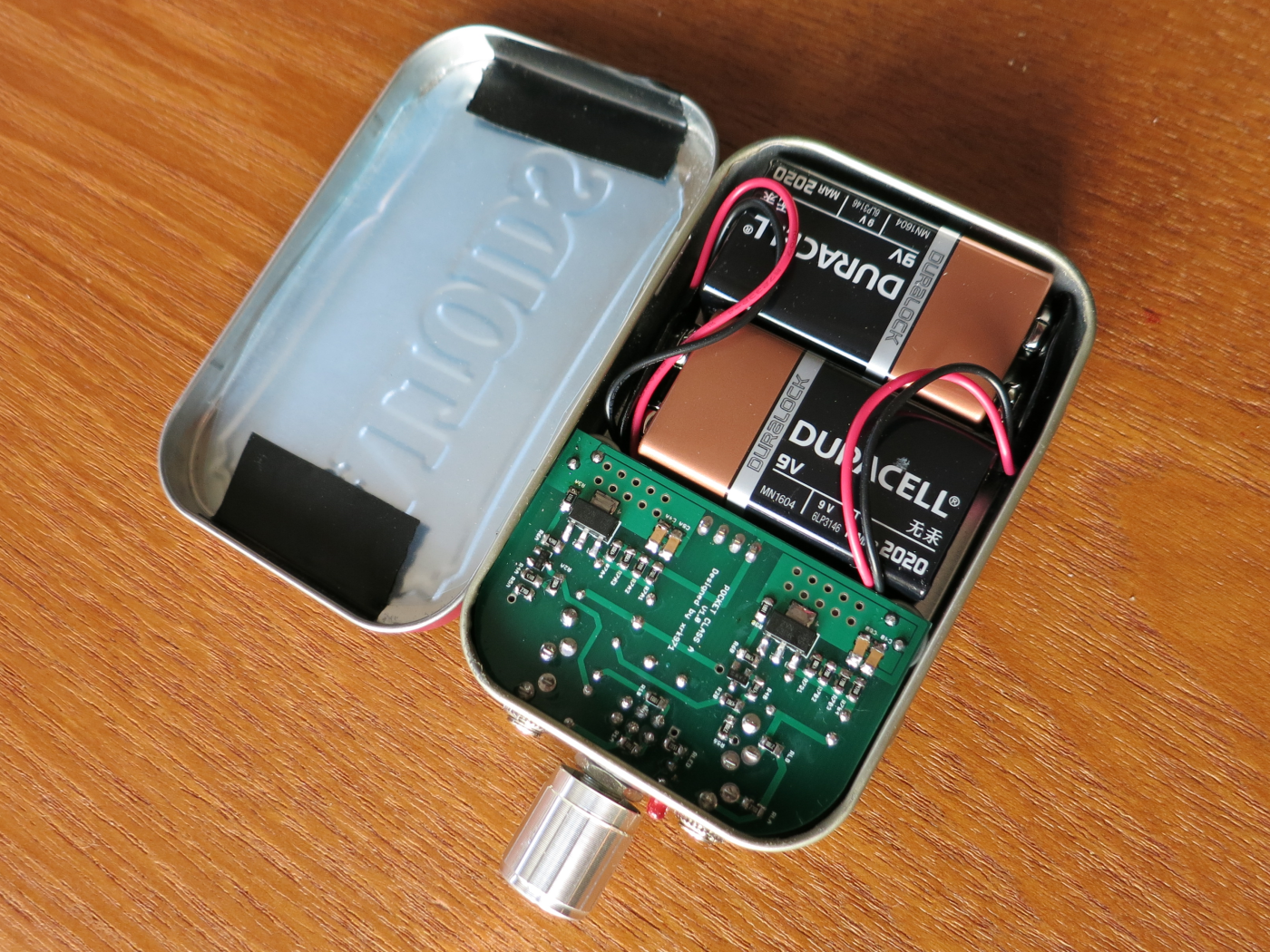I crossed paths with XRK971 a few months ago on the diyaudio.com forums as we worked concurrently on Class A single-ended headphone designs. Although we did not collaborate and our parts choices differed, our overall topologies share a strong resemblance. After chatting a bit, we exchanged some parts so that each could hear what the other had come up with. The major difference between our amps is that my desktop amp uses a tube for voltage gain, while XRK’s portable amp uses a JFET. The MOSFET source-follower output stages are otherwise very similar.
The most striking aspect of XRK’s Pocket Class A amp, aside from the sound (more on that later), is that it fits in a mint tin, just like the original CMoy opamp implementation. If you’ve been around headphone amp DIY for any time at all, you have probably come across this classic DIY amp. Although the designs share a form factor, don’t think of XRK as an iconoclast. The Pocket Class A is an alternative, not a replacement, and for the price of admission, many DIYers should probably try both. I mean, why do you think Altoids makes both cinnamon and peppermint flavors? Variety, baby.
Design overview
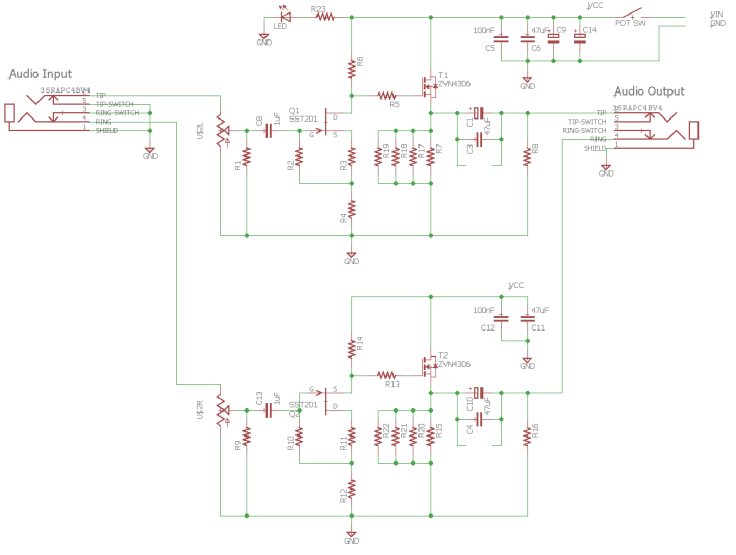
Rather than an integrated opamp (as in the CMoy), the Pocket Class A uses two stages of discrete transistors. Opamps are extremely linear devices when given the right load and operating conditions, but many people (especially DIY enthusiasts) prefer the flexibility and tweakability of discrete parts. The debate over whether discrete parts or integrated circuits sound better is almost as old as the debate between tubes and solid state, but one thing is undeniably true: you can run discrete parts at higher voltage and power levels without killing them. In a Class A circuit, this usually pays sonic dividends.
The first stage of the Pocket Class A is a BF862 JFET, a popular part for voltage gain duty in preamps and headphone amplifiers. The JFET is configured in a common source arrangement much as would be done in vacuum tube voltage gain stages. This first stage is directly coupled to a ZVN4306 MOSFET configured as a source follower. While a source follower does not provide voltage gain, it does provide current gain, lowering the output impedance and allowing the amp to drive lower impedance headphones (XRK specs the design down to 30 ohms).
Finally, this is all run on a pair of 9V batteries in series for 18V overall. Compared to many DAPs and phones, 18V is quite a generous power rail and allows much larger voltage swings into high impedance headphones. In addition, using batteries, rather than a wall-wart, provides an extremely clean DC power source for the amplifier and, of course, makes it plenty portable. The trade off here is that a Class A power draw means the batteries only last 4 to 5 hours. Get you some rechargeables, post haste.
Parts Quality
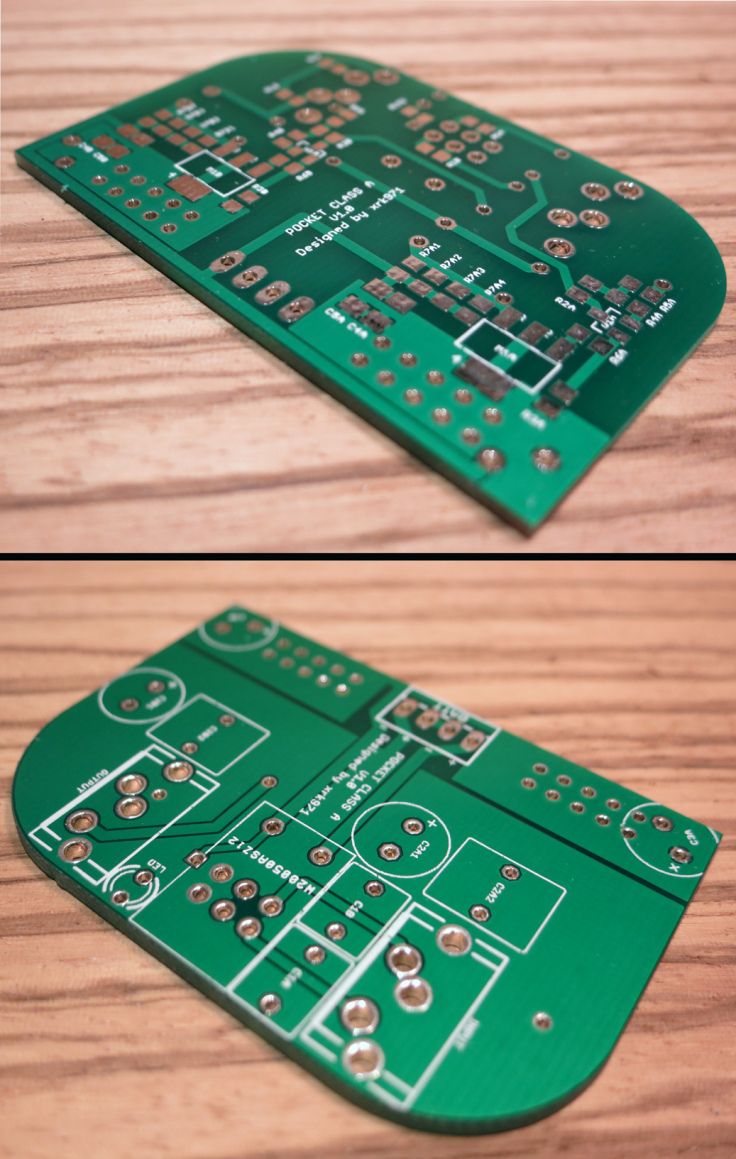
Because I worked only from XRK’s board and ordered my own parts from Digikey, the board is the only aspect on which I can comment as far as quality. XRK supplies a BoM with board orders that includes part numbers for good quality parts and this is what I would recommend to most builders. Because this is a small board, you must pay attention to parts dimensions if picking your own caps.
The board layout is well done and comfortable without having to resort to too much contortion or special solder iron tips for a reasonably nimble solder slinger. The board itself is excellent quality and mine survived a couple of de-solderings when I wasn’t paying close enough attention to what I was doing. The ground planes are not large enough to require a high power iron, so even the cheap 25W Radio Shack pencil in your toolbox will work if the tip is in good shape. Silk screening is large enough and clear and I had no trouble identifying part locations.
The only usability quibble I have with the board is the layout of the jacks and knob. They fit in the tin without a problem, but the tight symmetrical layout will require that some builders mark the amp in some way to differentiate input from output. The spacing around the knob is tight, requiring a narrow knob and cable connectors that are not too bulky. These are minor points and I’m sure the alternatives have trade-offs, but they demonstrate the homegrown nature of the group-buy boards. Then again, an amp in a mint tin is not often mistaken for something other than DIY geekery.
Documentation
Click here for a Bill of Materials PDF
There are expansive threads on diyaudio.com and head-fi.org full of builder feedback. XRK has done everyone a service by filling the initial post with all the relevant links, resources, and schematics. You should not have to go digging for the essential information. I have come to expect and value lengthy discussions on the design process and theory when building from a board or kit, but I also understand that the basics are really what most people want and make use of. If you read through the threads, you will find some in-depth discussion.
The board does not come with a printed copy of the schematic and I would encourage XRK to include one. I often work from a tablet when building projects because, like many people, I don’t have a home printer anymore (ink cartridge$). Dealing with viewing angles and power-saving screens can get annoying, especially with a hot iron in your hand. Having a hard copy of the schematic, which should cost next to nothing to produce, would be a nice touch, I think. Again, it’s a minor point that has nothing to do with performance, but reviews of a DIY product encompass both the process and the end-result.
Difficulty
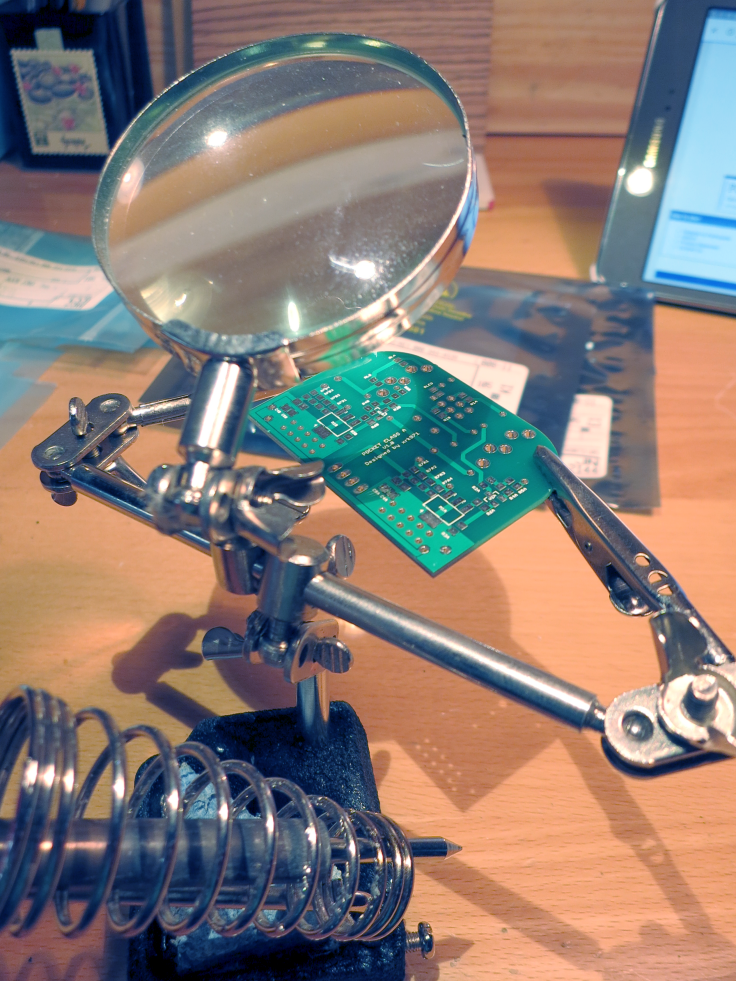
I would put this kit at a beginner to intermediate difficulty level. If you have never soldered before, this may not be the easiest place for you to start. The SMD parts and the pads they attach to are small and somewhat delicate (though the high quality board should prevent lifted traces). You should have a clean, fine tip on your iron when approaching the build. That said, if you are reasonably comfortable with an iron, this would make an excellent introduction to SMD work. There are not too many parts and everything has a good amount of space around it. It’s been awhile since I personally have done any SMD work and I had no issues. I drink way too much coffee, too.
The only chassis or fabrication work to speak of is punching holes in the tin for the jacks and switched volume pot. XRK provides a PDF chassis hole layout (again maybe, something to include a hard copy of) and recommends a regular hole punch. You don’t even need a power tool.
Sound Quality
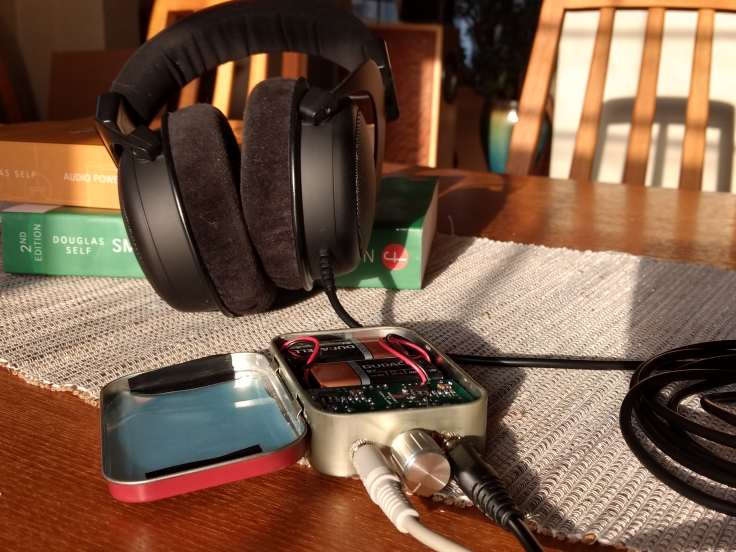
I know this is really why you’re reading this article. How does it sound? In short, the Pocket Class A is budget excellence. Low impedance headphones (<50 ohm), the true test of this kind of design, benefit from the relatively high current MOSFET output stage and are able to reach higher volume levels than the same headphone played straight from a smartphone. They do so without distorting objectionably. High impedance headphones (>150 ohm) on-the-go are the real target here, I suspect, and they perform outrageously well for the small cost of parts and simplicity of the design. Volume levels, due to the 18V power supply, surpass anything you can get from a smartphone or tablet.
The Blue Lola is a sealed headphone design with an impedance of 42 ohms. I imagine that sealed headphones of this low-to-mid impedance will be a common partner to a portable amp like the Pocket Class A. With the volume knob on the amp at about halfway, the headphones reach satisfying levels (with relatively more room to spare than if used directly). Bass has more dynamic impact and is tighter than straight from a phone (Motorola Z Play, iPhone 7 with dongle) or a tablet (Samsung Galaxy, iPad Mini). Yosi Horikawa’s track “Starlings” has a throbbing synth that few portable sources do justice. The Pocket Class A does a good job of enveloping the track in this synth line without losing the delicate atmospheric melody.
The Logitech UE900s are a quad-armature in ear monitor with an impedance of 30 ohms (the lowest impedance the amp is rated to support). If the amp has any objectionable noise, in-ears will probably pick it up. On initially using the IEMs, I encountered some slight noise while turning the volume knob. After playing with the amp for a while, this disappeared; I believe this was probably just a dusty pot. The Pocket Class A is otherwise silent. Because the output caps are 390uF, the corner frequency of the high pass filter formed is about 14Hz. While this is below the lowest fundamental frequency we usually encounter in music, it specifies the -3dB point (half power) and so roll-off starts slightly higher.
In practice, I did not notice any deficiency in bass with the Horikawa track or Zero 7’s “Passing By.” According to Douglas Self’s testing for “Small Signal Audio Design,” electrolytic caps must be generously oversized not only for frequency considerations, but also because marginally sized caps create distortion at low frequency. I did notice some minor harshness and loss of resolution in busy passages on Lemon Jelly’s “The Staunton Lick,” but it was minor and difficult to attribute to the caps, amplifier, or headphones specifically. Larger output caps would quickly run into space constraints with this amplifier, and I’d sooner use the specified 390uF than let audio paranoia ruin the otherwise excellent listening experience. With the UE900s, Ray Lamontagne’s “You Can Bring Me Flowers” paints an intimate picture with suitable spaciousness in the cymbal work and realistic woodwinds late in the track.
High impedance headphones are where this amp should shine brightest and the Beyerdynamic DT880 at 250 ohms does not disappoint. The mid-range, no doubt due to the single-ended JFET gain stage, is wonderfully organic and natural on the Lamontagne and Zero 7 tracks and the detail retrieval and resolution of space on the busy intro to Horikawa’s “Starlings” is excellent for a pocket amplifier. The treble is relaxed and natural (especially cymbals) with no harshness or sibilance; any hint of struggle between headphone and amp on the Lemon Jelly track is gone and replaced with a single-ended class A sense of flow and leisure.
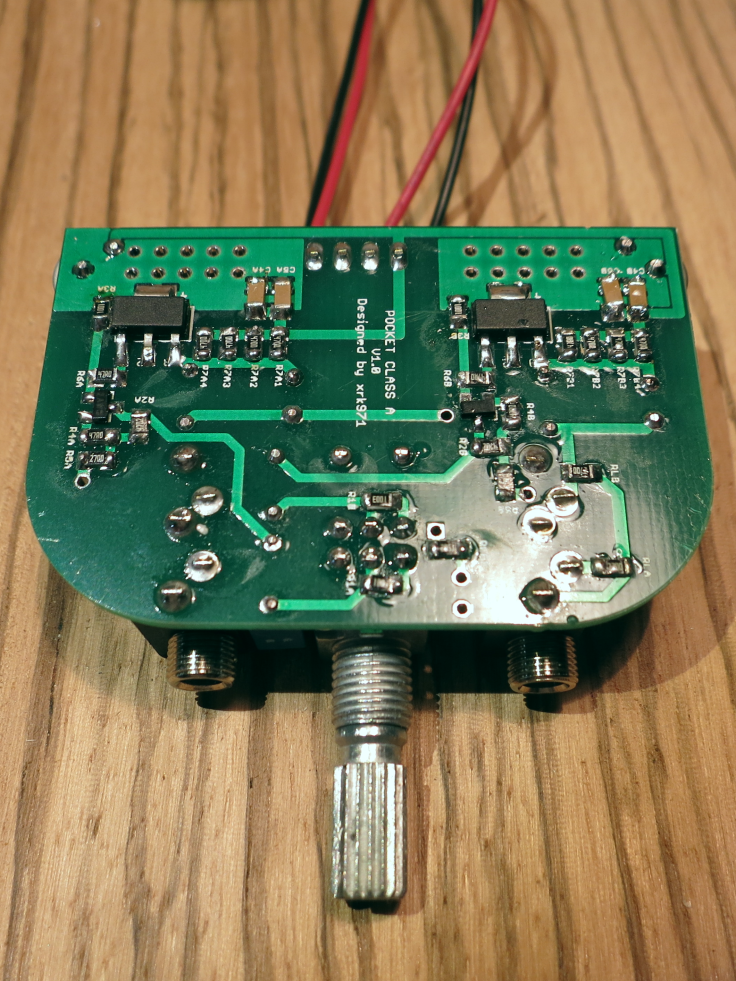
Is the Pocket Class A as revealing or detailed as a full-size desktop amplifier that costs five times the price in parts? No, but that is not what the Pocket Class A should be. It’s in a tin for crying out loud. As primarily a tube amp builder (take that as you may), I would be quite satisfied with this amp as a portable alternative. Its THD rating (spec’d at 0.029% or -70dB) is not particularly inspiring, but the harmonic spectrum decays monotonically and is dominated by the 2nd harmonic (with the 3rd a good 15dB lower). Considering that it is likely to be used on-the-go from a smartphone by builders, most would embrace the subtle warmth provided by the single-ended design. Volume levels are more than enough, frequency response is good, tone is neutral with a slightly warm tilt. There isn’t anything not to like about the sound.
Like many electrolytic-coupled amplifiers, the Pocket Class A does have a low level thump on power up and power down. This is nothing to worry about and is a common result of using large electrolytic capacitors to couple the output. At no point in using it did I worry for the safety of any of my headphones.
Sources: Motorola Z Play, iPhone 7 w/dongle, iPod Classic, iPad Mini 4th Gen
Headphones: Logitech UE900, Blue Lola, Beyerdynamic DT880-250 ohms
Test tracks: Yosi Horikawa “Starlings”, Zero 7 “Passing By”, Lemon Jelly “The Staunton Lick”, Ray Lamontagne “You Can Bring Me Flowers”
Dork Factor
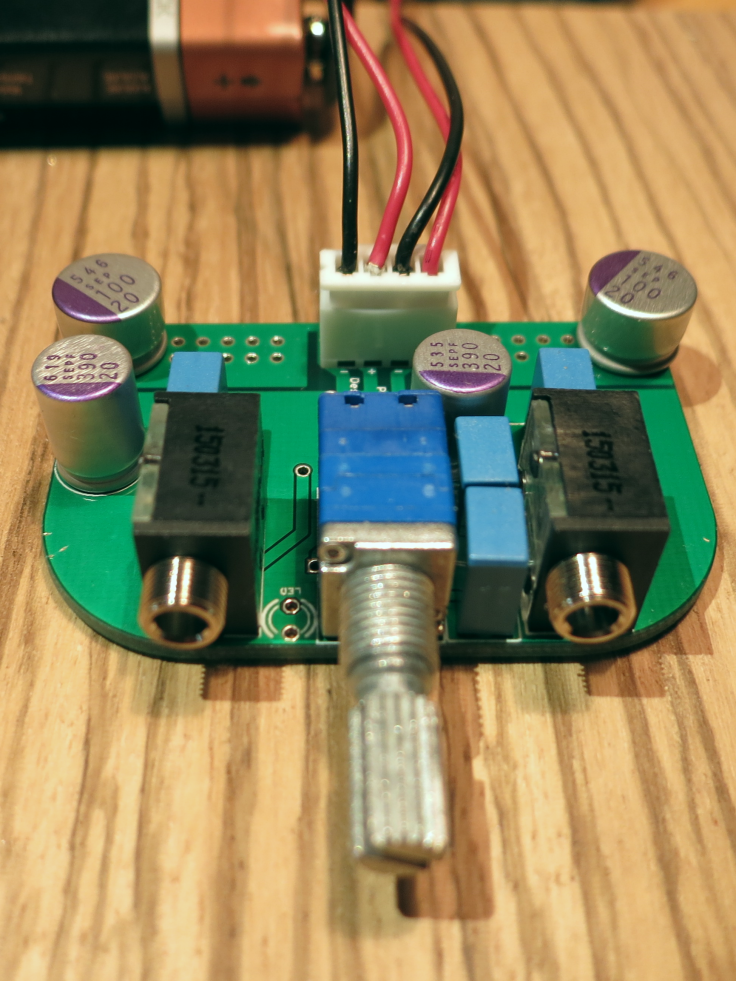
This is single-ended Class A in your pocket and it gets warm (but not hot). Dork factor is off the charts. It is also in a tin and not a CMoy, so even your DIY friends will care. To top it off, it is an approachable but challenging build and costs less than a fancy haircut.
Final word: whether you are a beginner with a little soldering under your belt or an experienced builder, this is a fun and rewarding project. Recommended!

Specifications provided by XRK971:
| Noise floor | -125dB |
| Dynamic range | 96dB |
| THD (@ 1kHz, 0.7Vrms, 270 ohms) | 0.029% or -70dB |
| Frequency response | -1.5dB @ 20Hz-45kHz |

